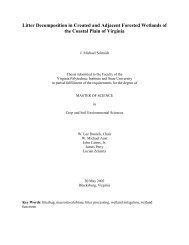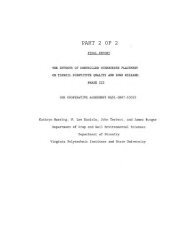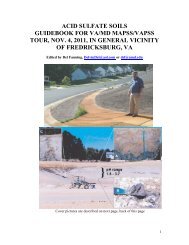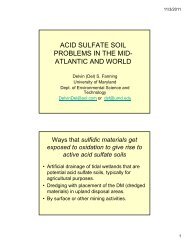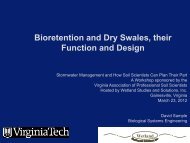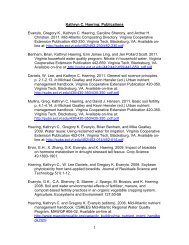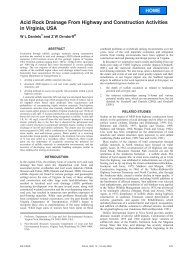Remediation of PAH-Contaminated Soils and Sediments: A ...
Remediation of PAH-Contaminated Soils and Sediments: A ...
Remediation of PAH-Contaminated Soils and Sediments: A ...
You also want an ePaper? Increase the reach of your titles
YUMPU automatically turns print PDFs into web optimized ePapers that Google loves.
oot extract resulted in continuous linear disappearance <strong>of</strong> pyrene <strong>and</strong><br />
benzo[a]pyrene. They found that linoleic acid is a powerful stimulant <strong>of</strong><br />
pyrene <strong>and</strong> benzo[a]pyrene degradation by gram positive bacteria. They<br />
hypothesized that (1) linoleic acid increased numbers <strong>of</strong> degrading<br />
bacteria, or (2) linoleic acid acted as a surfactant to increase the<br />
bioavailability <strong>of</strong> the <strong>PAH</strong>, or (3) linoleic acid formed a coating on soil<br />
particles <strong>and</strong> increased the attachment <strong>of</strong> bacteria to hydrophobic sites,<br />
which enhanced their proximity to <strong>PAH</strong> compounds.<br />
Bioaugmentation<br />
Bioaugmentation is the introduction (or inoculation) <strong>of</strong> a specific competent<br />
microorganism or group <strong>of</strong> microorganisms to improve the metabolic capacity <strong>of</strong><br />
the indigenous population <strong>of</strong> microbes (Gentry et al., 2004). For example,<br />
Mycobacterium sp. are known to have extremely lipophilic surfaces so they are<br />
better equipped to directly take up organic hydrophobic contaminants such as<br />
<strong>PAH</strong>s (Rehman et al., 1998; Bogan et al., 2003). Bioaugmentation can be<br />
especially useful in sites with high <strong>PAH</strong> concentrations, in recently polluted soils<br />
with limited adapted microbial populations, or in aged soils/sediments where the<br />
<strong>PAH</strong> pr<strong>of</strong>ile is dominated by HMW <strong>PAH</strong>s (Mueller et al., 1989).<br />
Successful field-scale applications <strong>of</strong> bioaugmentation are limited (Alex<strong>and</strong>er,<br />
1999). Bioaugmentation is still experimental with most successful cases reported<br />
in confined systems where conditions are controlled to favor the growth <strong>of</strong> added<br />
microbes. There are several reports <strong>of</strong> the usefulness <strong>of</strong> bioaugmentation in<br />
enhancing bioremediation <strong>of</strong> contaminated soils (Lendvay et al., 2003; Silva et<br />
al., 2004), <strong>and</strong> others reporting that the procedure has failed to improve<br />
biodegradation (Bouchez et al., 2000). Some lab-scale or demonstration-scale<br />
experiments <strong>and</strong> summaries are presented below:<br />
� Pritchard et al. (2002) found that introducing Sphingomonas paucinobilis<br />
EPA 505 along with nutrients <strong>and</strong> biosurfactants in a lab microcosm<br />
containing Superfund soils did not improve <strong>PAH</strong> degradation. They<br />
suggested that the addition <strong>of</strong> microorganisms to improve biodegradation<br />
in such highly contaminated soils might be limited by the microorganisms’<br />
sensitivity to toxic components <strong>and</strong> competition with indigenous<br />
community.<br />
� Microbes introduced to a field setting in liquid cultures have poor survival<br />
due to predation <strong>and</strong> competition (O’Reilly <strong>and</strong> Crawford, 1989). For<br />
successful bioaugmentation, the added microorganism must fill a nonutilized<br />
metabolic niche in the microbial community <strong>and</strong> be protected by<br />
encapsulation or addition in a bi<strong>of</strong>ilm (Watanabe et al., 2002; El Fantroussi<br />
<strong>and</strong> Agathos, 2005). Inert materials such as vermiculite can be used as<br />
carriers to extend the survival <strong>of</strong> microbial cultures (Weir et al., 1995).<br />
Other methods to assist microbial introduction include the addition <strong>of</strong> preadapted<br />
strains or consortia <strong>of</strong> degraders, the addition <strong>of</strong> genetically<br />
47



